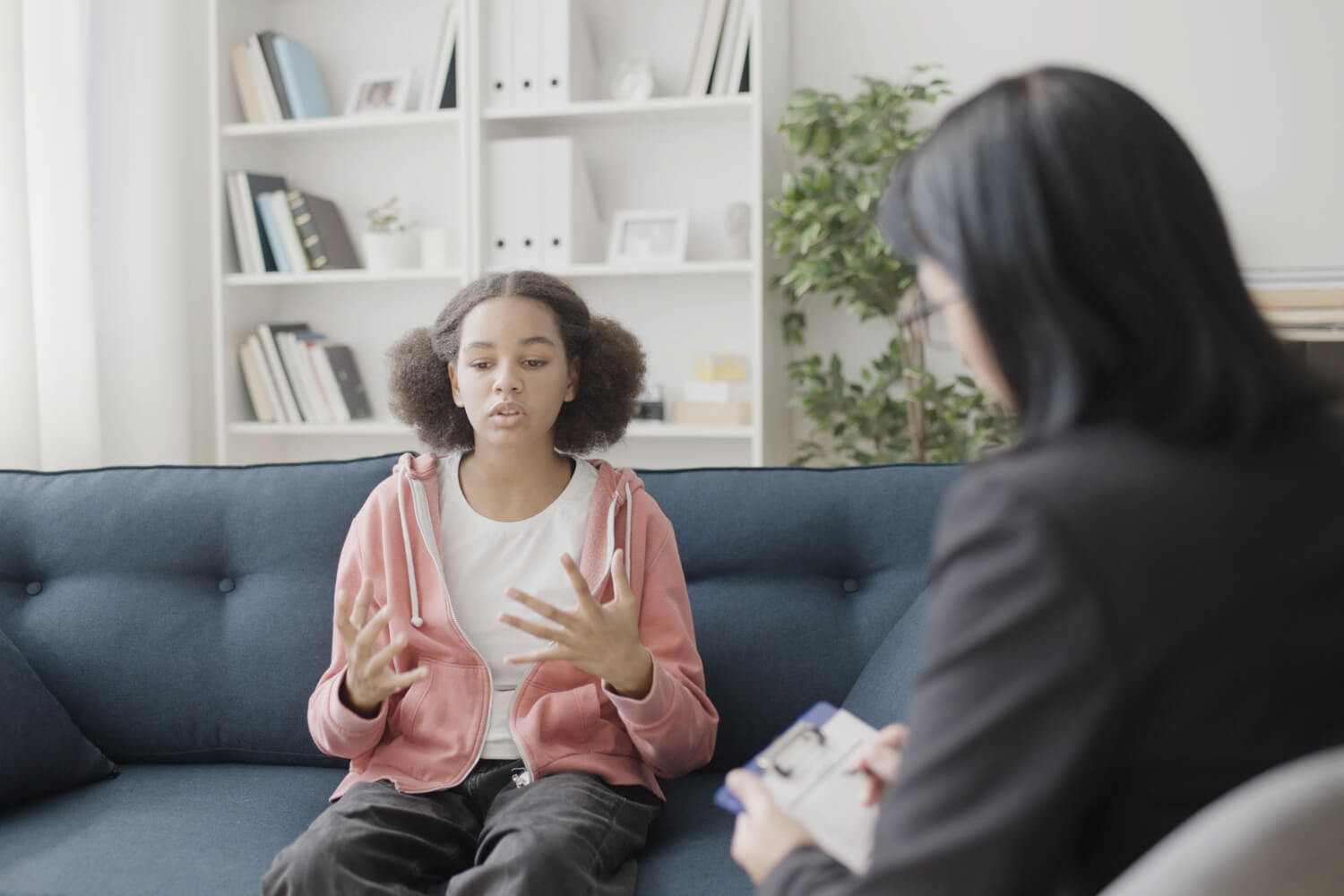Ways a Youth Therapist encourages self-expression in non-verbal ways
Checking Out the Various Types of Treatment Available for Teenagers With a Therapist for Teenagers
Young adults encounter one-of-a-kind obstacles that can influence their mental health and wellness. Various healing methods are tailored to attend to these issues efficiently. From Cognitive-Behavioral Treatment (CBT) to Art Therapy, each modality provides unique benefits. Comprehending these therapies can assist caregivers make informed decisions. What aspects should be considered when choosing the right approach for a teen? The exploration of these various treatments reveals understandings that can significantly enhance adolescent well-being.
Recognizing Cognitive-Behavioral Treatment (CBT) for Teenagers
Cognitive-Behavioral Therapy (CBT) serves as a powerful device for dealing with the distinct psychological wellness difficulties encountered by teenagers. This evidence-based strategy concentrates on the interplay between behaviors, sensations, and thoughts, helping teenagers identify and transform adverse thought patterns that add to their struggles. Via structured sessions, specialists assist teenagers in acknowledging their cognitive distortions, promoting healthier coping systems and emotional regulation.
CBT is specifically reliable in managing anxiousness, depression, and behavioral problems, as it furnishes teens with practical abilities to navigate their everyday lives. The therapy urges self-reflection and promotes a proactive mindset, encouraging teens to take control of their psychological wellness journey. By establishing particular goals and utilizing different techniques, such as journaling and role-playing, CBT promotes durability and self-awareness. Overall, this healing strategy supplies teens with essential devices to challenge their obstacles and develop an extra favorable expectation on life.
The Advantages of Dialectical Behavior Modification (DBT)
While lots of healing techniques offer valuable understandings for adolescents, Dialectical Behavior modification (DBT) stands apart for its efficiency in attending to psychological law and social challenges. Developed by Dr. Marsha Linehan, DBT combines cognitive-behavioral techniques with mindfulness methods, making it especially appropriate for teenagers grappling with extreme feelings. This treatment aids teenagers recognize and recognize their sensations, advertising much healthier reactions to stressors.
Among the considerable advantages of DBT is its concentrate on building abilities in 4 vital locations: mindfulness, social effectiveness, distress resistance, and emotional policy. These skills encourage teenagers to browse complicated connections and cope with tight spots more efficiently. In addition, DBT urges a solid restorative partnership in between the specialist and the teen, cultivating trust fund and openness. Because of this, lots of teens experience boosted emotional stability and enhanced coping devices, ultimately resulting in a much more fulfilling life and stronger connections with peers and family.
Discovering Art Treatment as a Creative Outlet
Art therapy supplies teens a special method for self-expression and psychological exploration (Youth Counselling Near Me). Via numerous techniques and approaches, it enables them to interact sensations that may be hard to articulate vocally. By taking part in innovative activities, teenagers can experience healing advantages that promote mental wellness
Advantages of Art Therapy
Participating in art treatment offers teenagers with a distinct creative electrical outlet that promotes psychological expression and personal understanding. This restorative method permits teenagers to communicate feelings and experiences that might be difficult to express verbally. Via various types of artistic expression, such as drawing, paint, or sculpting, teens can check out and process complex emotions, bring about boosted self-awareness. Additionally, art therapy advertises leisure and anxiety relief, using a safe room for people to release bottled-up emotions. The non-judgmental atmosphere encourages trial and error, assisting teens build self-confidence in their creativity and analytic skills. As a result, art treatment can boost general psychological well-being, giving a valuable tool for handling life's challenges during this vital developing stage.
Methods and methods
When checking out art therapy as an innovative electrical outlet, different techniques and approaches can be employed to promote psychological expedition and expression. These might include drawing, paint, collage-making, and sculpting, enabling teenagers to communicate feelings that could be challenging to express verbally. Led imagery can likewise be utilized, urging people to visualize and develop representations of their emotions. Furthermore, the consolidation of music or motion can enhance the imaginative process, fostering a much deeper connection to their inner experiences. Group art tasks offer possibilities for social communication and shared healing. Importantly, the emphasis in art treatment exists not on creative skill yet on the procedure of development, equipping teens to discover their own distinct kinds of self-expression and insight.
Art as Expression
Imagination acts as an effective channel for self-expression, particularly for teens steering complicated feelings. Art therapy uses a special electrical outlet for adolescents to explore and connect sensations that might be hard to articulate vocally. Via drawing, paint, or sculpting, teenagers can picture their internal battles, fostering a sense of understanding and launch. This healing approach permits individual analysis and motivates expedition without judgment. Furthermore, involving in creative tasks can improve self-worth and advertise emotional strength. As teens develop, they may find new point of views on their obstacles, causing healing and individual development. Inevitably, art treatment serves as an essential source, encouraging teens to navigate their emotional landscapes with innovative expression.
The Role of Family Treatment in Teen Mental Wellness

Benefits of Household Involvement

Communication and Problem Resolution
Reliable communication and conflict resolution are crucial components of teenage psychological health, particularly within the context of family members therapy. Household treatment provides an organized setting where teenagers can share their sensations and thoughts, fostering open discussion. This healing setup urges member of the family to proactively listen per various other, advertising understanding and compassion. By attending to disputes in a secure room, teenagers find out beneficial skills for taking care of differences constructively, which can decrease emotional distress. In addition, these skills boost household characteristics, leading to much healthier partnerships. As teenagers browse the intricacies of their feelings, household treatment equips them with devices to communicate effectively, resolve disputes agreeably, and strengthen domestic bonds, eventually supporting their general psychological health.
Utilizing Mindfulness-Based Treatment for Stress Reduction
As adolescents navigate the complexities of adolescent life, incorporating mindfulness-based therapy can function as a powerful tool for stress and anxiety reduction. This restorative technique stresses present-moment recognition, helping teenagers confront their thoughts and sensations without judgment. By exercising mindfulness methods such as deep breathing, body scans, and guided images, teenagers can learn to take care of anxiety and stress and anxiety better.
Research study shows that mindfulness-based treatment can improve emotional law and strength in teens, allowing them to cope better with scholastic stress and social challenges (Youth Counselling Near Me). Routine practice can lead to improved focus, minimized impulsivity, and higher overall wellness. Furthermore, mindfulness fosters a sense of link to oneself, advertising self-compassion and minimizing unfavorable self-talk
Integrating mindfulness into therapy sessions provides teenagers sensible methods they can use in daily life, empowering them to see this website navigate stressors with higher ease and self-confidence. Therefore, mindfulness-based therapy becomes an important resource in supporting teenage psychological health and wellness.
Integrating Play Therapy for Younger Teens and Preteens

Therapists learnt this approach create a risk-free setting where more youthful teenagers can explore their issues and create coping strategies. By engaging in play, these individuals can better comprehend their emotions and learn to steer social communications. Additionally, play therapy can foster durability and analytical abilities, important for browsing the obstacles of teenage years. In general, incorporating play therapy can enhance the healing process, providing more youthful teenagers and preteens with the devices they need to thrive psychologically and socially.
Frequently Asked Inquiries

Just how Do I Know if My Teenager Requirements Treatment?
Indicators that a teenager may need therapy consist of relentless unhappiness, adjustments in behavior, withdrawal from good friends or tasks, scholastic decline, boosted stress and anxiety, substance use, or difficulty dealing with life adjustments. Observing these indicators can motivate professional evaluation.
What Qualifications Should I Look for in a Teenager Specialist?
When seeking a teen specialist, one should prioritize credentials such as relevant levels in psychology or therapy, state licensure, specialized training in teenage problems, and experience collaborating with teens in different healing setups.
How Can I Support My Teenager During Therapy?
To sustain a teen during therapy, one must actively pay attention, use encouragement, respect their privacy, and verify their feelings. In addition, fostering open communication can assist them really feel more comfortable discussing their experiences and feelings.
What Prevail Indicators of Mental Health Issues in Teenagers?
Usual signs of psychological wellness concerns in teenagers include persistent sadness, withdrawal from close friends and tasks, adjustments in rest or hunger, difficulty focusing, boosted impatience, material misuse, and obvious declines in academic performance or self-worth. (Youth Counselling Near Me)
The Length Of Time Does Therapy Usually Last for Teenagers?
Therapy period for teenagers commonly varies, frequently lasting from a couple of weeks to several months. Factors influencing this timeline consist of the individual's certain requirements, the sort of treatment, and development made during sessions.
From Cognitive-Behavioral Treatment (CBT) to Art Treatment, each technique provides distinct advantages. Cognitive-Behavioral Therapy (CBT) serves as an effective tool for addressing the unique mental wellness challenges dealt with by teenagers. Involving in art treatment supplies teens with an unique imaginative outlet that promotes emotional expression and personal understanding. Household therapy gives a structured atmosphere where teens can express their ideas and feelings, promoting open discussion. Study indicates that mindfulness-based treatment can improve check emotional guideline and durability in teens, permitting them to cope better with social difficulties and scholastic pressures.